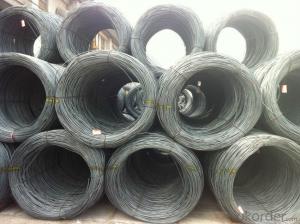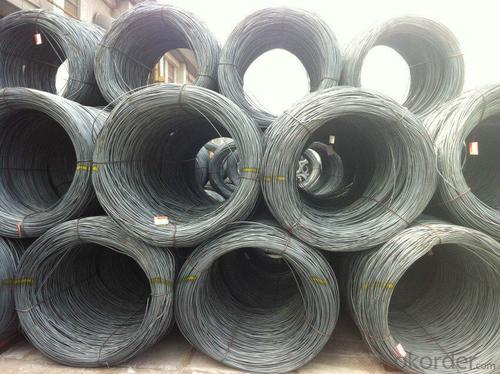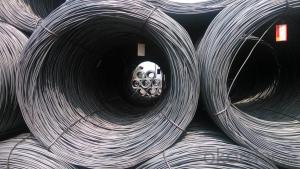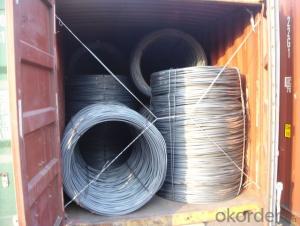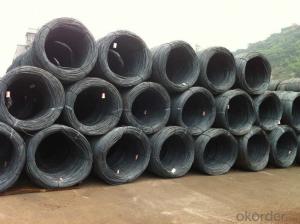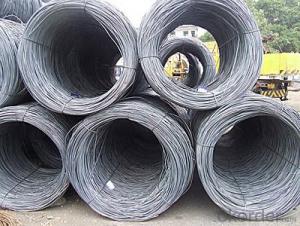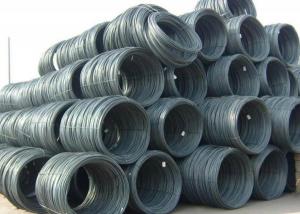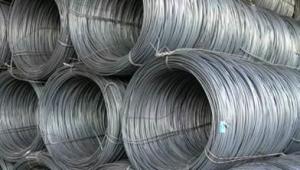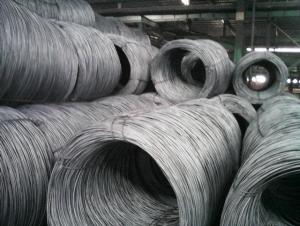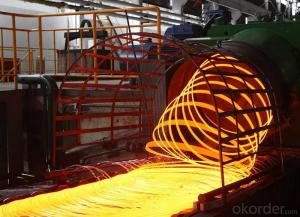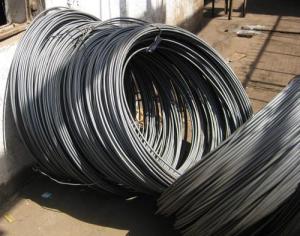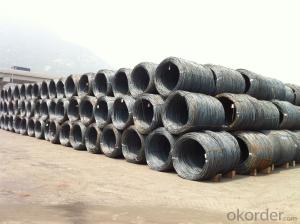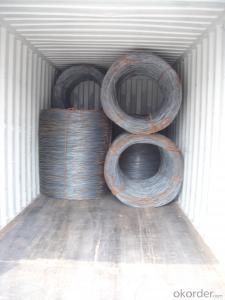Supply 6.5mm steel wire rod in coils in sale
- Loading Port:
- Tianjin
- Payment Terms:
- TT OR LC
- Min Order Qty:
- 25 m.t.
- Supply Capability:
- 500000 m.t./month
OKorder Service Pledge
OKorder Financial Service
You Might Also Like
Specification
Steel Grade: Q195/235, SAE1006-1018B Standard: ASTM, GB
Diameter: 5.5mm, 6.5mm, 7mm,8mm,9mm,10mm,12mm,14mm
Type: Drawn Wire Alloy or Not: Alloy Brand Name: HSKY
Technique: Hot Rolled Place of Origin: China Mainland
Chemical Composition:(Please kindly find our chemistry of our material based on SAE1006B and SAE1008B as below for your information)
High carbon/Low carbon/common carbon Steel wire rod | With boron for rebate tax |
Grade | SAE1006B SAE1008B SAE1018B |
Package | In coil ,in bundle, |
Coil weight | about 2000kg-3000kgs |
Size: | 5.5mm 6.5mm 8mm 10mm 12mm 14mm 16mm |
Types | High Carbon ,Low carbon ,Common carbon |
Exported Country | South Korea,Vietnam,Indonesia,Myanmar,Philippines and Afrca,Ect |
Delivery term: | within 30 days after receive the LC |
Payment Term: | LC at sight ,LC 30-120 days after B/L date, TT payment |
The Standard of Physical Properties:
Grade | Chemical Composition(%) | |||||
C | Mn | Si | S | P | Cr | |
SAE1006 | 0.03~O.07 | ≤0.32 | ≤0.30 | ≤0.045 | ≤0.040 | >0.30 |
Mechanical properties | ||||||
Yield strength(N/mm2) | Tensile strength(N/mm2) | Elongation(%) | ||||
250-280 | 350-380 | ≥32 | ||||
Grade | Chemical Composition(%) | |||||
C | Mn | Si | S | P | Cr | |
SAE1008 | 0.10max | 0.3~O.50 | 0.15max | 0.050max | 0.040 max | 0.30 min |
Mechanical properties | ||||||
Yield strength(N/mm2) | Tensile strength(N/mm2) | Elongation(%) | ||||
≥195 | 315-430 | ≥30 | ||||
Usage and Applications of Steel Wire Rod in Coil:
After hot-rolled the products shaped into coil and delivery as finished product, including round, square, rectangular, hexagonal and so on, Since most of the products are round, it is generally called wire rod. Steel wire rod is widely used in construction and manufacturing. Steel wire rod is mainly used for reinforcement of reinforced concrete and welded structure or reprocessed (roberts, nail etc) materials, especially used to produce wire drawing, welding electrode, nails,spring, electronic, precise machinery parts and so on.
Packaging & Delivery of Steel Wire Rod in Coil:
Packaging Detail: products are packed in coil and then shipped by container or bulk vessel
Each coil weight: 2-3MT
Delivery Detail: within 45 days after received deposit or LC.
Label: to be specified by customer, generally, each bundle has 1-2 labels
Trade terms: CFR, CIF
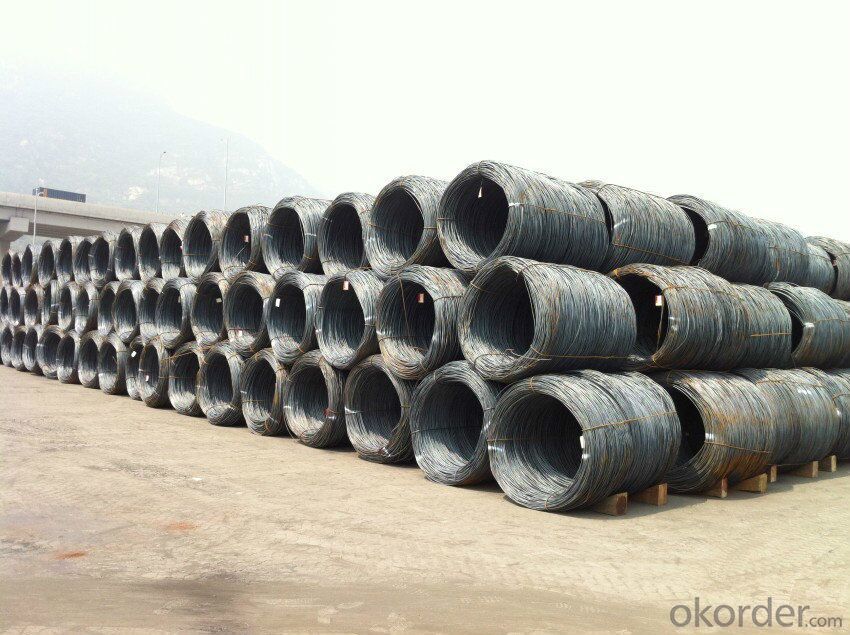
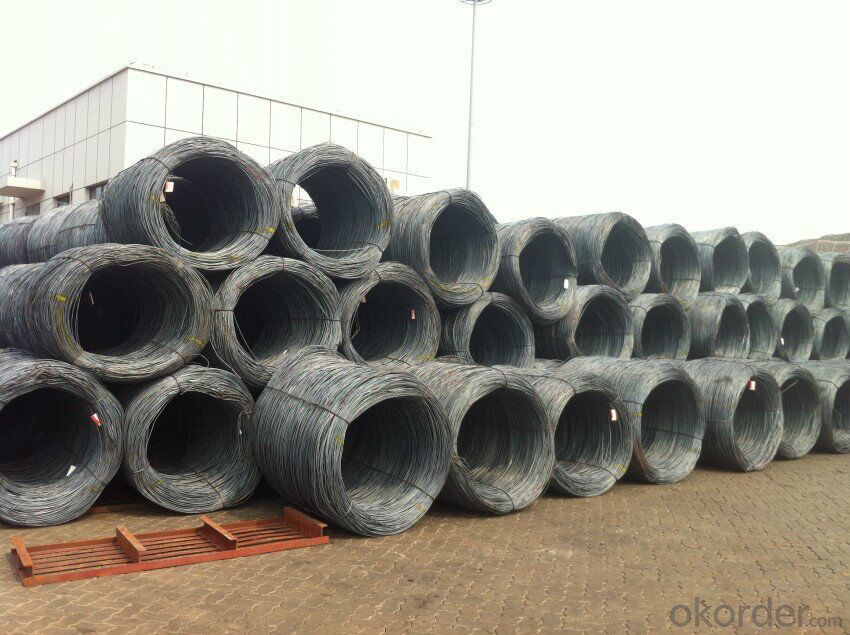
- Q: How is steel wire rod used in the production of fencing?
- Steel wire rod is used in the production of fencing as it serves as the main material for manufacturing the wires that create the mesh structure of the fence. The wire rod is first drawn through a series of dies to reduce its diameter and increase its strength, resulting in a thin and durable wire. These wires are then woven or welded together to form the fencing mesh, providing a strong and secure barrier for various applications such as residential, commercial, and agricultural fencing.
- Q: What are the common surface defects in steel wire rod?
- Common surface defects in steel wire rods include surface cracks, scratches, pits, scale, rust, and surface decarburization. These defects can affect the quality and performance of the wire rods and may require additional processing or surface treatment to rectify.
- Q: How is the corrosion resistance of steel wire rod determined?
- The corrosion resistance of steel wire rod is determined through various methods and tests. One common method is the salt spray test, also known as the ASTM B117 test. In this test, the steel wire rod is exposed to a controlled environment of salt mist or fog for a specified period of time. The wire rod is then evaluated for signs of corrosion, such as rust or discoloration. Another method used to determine corrosion resistance is the pitting corrosion test. In this test, the steel wire rod is exposed to a corrosive solution, such as a chloride solution, and the formation of pits or localized corrosion is monitored. The severity and extent of pitting corrosion can provide insights into the resistance of the wire rod to corrosive environments. Additionally, electrochemical methods such as the polarization resistance test and electrochemical impedance spectroscopy can be used to assess the corrosion resistance of steel wire rod. These tests involve measuring the electrical response of the wire rod when subjected to an applied voltage or current. By analyzing the resulting data, corrosion rates and potential susceptibility to corrosion can be determined. Other factors that can affect the corrosion resistance of steel wire rod include the composition of the steel alloy, the presence of protective coatings or surface treatments, and environmental conditions such as temperature and humidity. These factors are often considered in conjunction with the aforementioned tests to provide a comprehensive evaluation of the corrosion resistance of steel wire rod.
- Q: What are the different hardness testing methods for steel wire rod?
- There are several hardness testing methods for steel wire rods, including the Rockwell hardness test, Brinell hardness test, Vickers hardness test, and Knoop hardness test. Each method involves applying a specific amount of force or pressure to the surface of the wire rod and measuring the depth or size of the indentation left by the indenter. These tests help determine the hardness and strength of the steel wire rod, providing valuable information for quality control and material selection purposes.
- Q: How are steel wire rods used in the manufacturing of wire brushes for cleaning purposes?
- Steel wire rods are used in the manufacturing of wire brushes for cleaning purposes as they serve as the core material for the bristles of the brush. The rods are typically cut and shaped into various lengths and gauges, and then attached to a handle or base to create a brush. The steel wire bristles are strong and durable, allowing the brush to effectively remove dirt, rust, and debris from surfaces.
- Q: What are the common applications of high carbon steel wire rod?
- High carbon steel wire rod is commonly used in various applications such as manufacturing springs, wires, cables, nails, and reinforcing materials for concrete. It is also utilized in the automotive industry for making components like suspension springs and tire reinforcement. Additionally, high carbon steel wire rod finds application in the construction industry for producing steel meshes, fencing, and wire ropes.
- Q: What are the main factors influencing the choice of steel wire rod order return policy?
- The main factors influencing the choice of steel wire rod order return policy are the quality of the product, customer satisfaction, and market competition. Firstly, the quality of the steel wire rod plays a crucial role in determining the return policy. If the product is consistently of high quality and meets the customer's expectations, the need for returns will be minimal. In such cases, a more stringent return policy can be implemented, ensuring that only genuine defects or issues are eligible for returns. On the other hand, if the product quality is inconsistent or below standard, a more lenient return policy may be required to accommodate customer dissatisfaction and maintain good customer relations. Customer satisfaction is another important factor. A customer-centric approach should be taken into consideration while devising a return policy. By providing a flexible and hassle-free return policy, customers will feel more confident in their purchasing decisions, knowing they have the option to return the product if they are not satisfied. This can help build trust and loyalty, leading to repeat purchases and positive word-of-mouth recommendations. Additionally, market competition plays a significant role in determining the return policy. In a highly competitive market, where customers have numerous options to choose from, a lenient return policy can act as a differentiating factor. By offering a more favorable return policy compared to competitors, a company can attract more customers and gain a competitive edge. However, this needs to be balanced with the company's profitability and operational feasibility, as overly generous return policies can impact the bottom line. In conclusion, the main factors influencing the choice of steel wire rod order return policy are the quality of the product, customer satisfaction, and market competition. A well-planned return policy that considers these factors can help ensure customer loyalty, maintain a positive brand image, and stay competitive in the market.
- Q: What are the different types of steel wire rod coating processes?
- In the industry, there exist various types of steel wire rod coating processes. These processes aim to offer different levels of protection and enhance the wire rod's performance in diverse applications. Some commonly utilized coating processes comprise: 1. Galvanizing: A layer of zinc is applied to the steel wire rod in this process. Galvanizing delivers exceptional resistance to corrosion and finds extensive use in outdoor applications that expose the wire to severe weather conditions. 2. Phosphate coating: By treating the surface of the steel wire rod with phosphate compounds, a chemical process known as phosphate coating is employed. This coating improves the adhesion of subsequent coatings, such as paint or powder coating, and enhances corrosion resistance. 3. Electroplating: Using an electric current, a thin layer of metal like chromium or nickel is deposited onto the surface of the steel wire rod during electroplating. This process increases corrosion resistance and enhances the wire rod's appearance. 4. Polymer coating: The surface of the steel wire rod is covered with a layer of polymer material, such as PVC or polyethylene, in polymer coating. This coating safeguards against corrosion, abrasion, and chemical exposure, making it suitable for a wide range of applications. 5. Epoxy coating: Epoxy resin is utilized in epoxy coating to create a durable and corrosion-resistant layer on the steel wire rod. This type of polymer coating is commonly employed in applications that require high chemical resistance and mechanical strength. 6. Aqueous film forming foam (AFFF) coating: The AFFF coating is mainly used in fire-resistant applications of steel wire rods. It forms a thin foam layer on the surface, acting as a barrier against heat and fire to protect the wire rod. To ensure optimal performance and longevity of the steel wire rod, it is crucial to select the appropriate coating process based on the specific requirements of the application.
- Q: How is steel wire rod used in the manufacturing of wire forms for sliding doors?
- Steel wire rod is an essential component in the manufacturing of wire forms for sliding doors. It serves as the primary material for creating the framework and structure of the wire forms. Firstly, steel wire rod is selected for its high tensile strength and durability, making it an ideal material for withstanding the constant movement and stress that sliding doors experience. The wire rod undergoes a series of processes, including drawing and annealing, to enhance its mechanical properties and ensure it meets the required specifications. Next, the steel wire rod is formed into various shapes and sizes, depending on the specific design and requirements of the wire forms. This can be achieved through bending, cutting, and welding techniques. The wire rod is manipulated to create the necessary curves, angles, and dimensions needed to construct the sliding door wire forms. Once the wire forms are shaped, they are further processed to enhance their functionality and aesthetics. This may involve surface treatments such as galvanizing or coating to provide corrosion resistance and improve the overall appearance of the wire forms. Finally, the wire forms are assembled and integrated into the sliding door system. They are typically used to support the door panels, guide the movement of the doors along the tracks, and provide stability and smooth operation. The steel wire rod ensures that the wire forms can withstand the weight of the door panels and endure frequent opening and closing without deformation or failure. In summary, steel wire rod plays a vital role in the manufacturing of wire forms for sliding doors by providing strength, durability, and flexibility. It serves as the backbone of the wire forms, enabling them to function effectively and contribute to the overall performance of sliding doors.
- Q: What are the different testing standards for steel wire rod?
- There are several different testing standards for steel wire rod, which are used to ensure the quality and performance of the product. These standards cover various aspects of the wire rod, including its chemical composition, mechanical properties, surface condition, and dimensional tolerances. One of the most common testing standards for steel wire rod is the ASTM A510/A510M standard. This standard specifies the requirements for carbon steel wire rods and includes tests such as chemical analysis, tensile strength, elongation, and reduction of area. It also provides guidelines for the surface quality and dimensional tolerances of the wire rod. Another widely used testing standard for steel wire rod is the ISO 16120-1 standard. This standard specifies the general requirements for steel wire rod and includes tests such as chemical analysis, tensile testing, and surface inspection. It also provides guidelines for the dimensional tolerances and packaging of the wire rod. In addition to these standards, there are also specific testing standards for steel wire rod used in certain industries or applications. For example, the ASTM A961/A961M standard specifies the requirements for low-alloy steel wire rods for prestressed concrete and includes tests such as tensile strength, yield strength, and elongation. Similarly, the ISO 6935-2 standard specifies the requirements for steel wire rod used in the manufacture of wire for general purpose applications and includes tests such as tensile strength, elongation, and torsion. Overall, the different testing standards for steel wire rod ensure that the product meets the required specifications and can perform reliably in its intended applications. These standards help manufacturers, suppliers, and customers to have confidence in the quality of the steel wire rod and ensure its suitability for use in various industries and applications.
Send your message to us
Supply 6.5mm steel wire rod in coils in sale
- Loading Port:
- Tianjin
- Payment Terms:
- TT OR LC
- Min Order Qty:
- 25 m.t.
- Supply Capability:
- 500000 m.t./month
OKorder Service Pledge
OKorder Financial Service
Similar products
Hot products
Hot Searches
Related keywords
